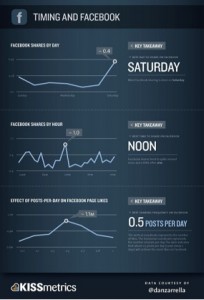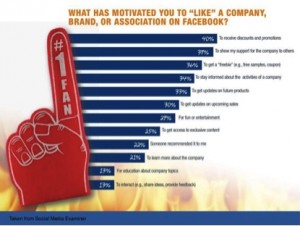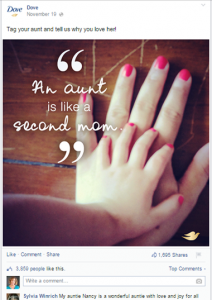Is your brand using Facebook but has no idea how to successfully market itself? Are you struggling for likes or user engagement? In this two part series you’ll find the quintessential guide to boosting your brands user engagement on Facebook. This post first sets out the way in which the basic parameters of the site can be utilised in a way to assure likes, then the actual content of the posting and finally it will provide tips on how to monitor the success of your page!
The site itself
The username
It’s key that a brand has a good username on Facebook, it should be identifiable and recognisable, which is essential to the success of branding (Dechanatory and MacDonald, 1998). Obviously it should be directly related to the company and allow for ease of access when it comes to searching for the brand (Gunelius, 2012).
It is also important to create a good ‘vanity URL’, which represents the brand, for the above reasons (Karasiewicz, 2013). The ‘vanity URL’ is where Facebook gives brands the option to create custom URLs, i.e. for this blog it would be www.Facebook.com/JosephDoddsDigitalMarketing, so it makes the page really easy to find if your have a good one! According to a study by the Social Media Examiner, 39% of users associated with a brand on Facebook, associate themselves with it in order to support the brand, if the brand isn’t easily identifiable then they would be able to associate.
The information on the page
Give the website in the about me as well as links to other social media, a brief description of what the brand is, perhaps angle the USP in this description to allow users to get a sense of who the brand is and what it offers before they have to commit to liking the page (Gunelius, 2012). A lack of information can prove fatal to attracting attention, let me pose this question, who would bother engaging with a brand when they have no idea who they are? The about me helps set the general message that the brand aims to convey, the more they do this the less time that customers contemplate purchases, meaning contemplate purchasing competitors products (Romaniuk & Gaillard, 2007).
According to Social Media Examiner, 21% of users like a brand to learn more about the company, whilst 34% like it to stay informed about the activities of a company, how can they do this with no accessible information? Simply put, a lack of information on the page itself will lose potential likes.
The cover photo and profile picture
Essentially the cover photo is the first thing that users will see if they click on a Facebook page (Gunelius, 2012), so it’s crucial that this is done right. The cover photo can be used to firstly identify the brand, then it can offer links to other social media as well as the brands website itself and thirdly it can show current promotions or future promotions that the brand has to offer, in the aforementioned study by Social Media Examiner, it was found that 33% of users want information on future products, 30% like a page to get information on upcoming sales, so this is a real opportunity to garner extra attention to the page. Additionally the profile picture should be the brands logo, once again to make it easily identifiable and recognisable (Gunelius, 2012).
If we take Business Insider for instance, you can see that their profile picture is a simple picture of their logo which is fairly identifiable, and the cover photo further reinforces the idea of corporate business by having people sitting at their desks. Saying that the page is slightly bland, perhaps if they had a more upbeat cover photo it would attract more engagement.

Recap:
- Choose an identifiable username
- Provide a descriptive about section
- Use the brands logo as profile picture
- Offer various promotional information via the cover photo
The posts:
The timing
The first thing to consider is how often and how frequently a brand should post on their Facebook, according to a study by Zorella (2012) the optimum posting frequency should be once every other day, although up to twice a day may also garner high levels of interaction for each post. In a 2012 study, Buddy Media concluded that posting once or twice per day will receive up to 40% more user engagement than posting three times per day. So it’s advisable to post about once per day to once per two days. However, InSight (2013) proposes that a brand post 2-5 times per day, this is not recommended as quite frankly it would spam users timelines, making them more likely to get frustrated with the brand.

The optimum time of posting appears to be at noon everyday, according to Zorella’s study, with significant interaction also taking place at 7pm, so any brand is advised to post around noon, as 7pm may be out of office hours, especially if the brand is fairly small.
That same study suggests that Saturday is the best day to post to ensure user engagement, however this doesn’t really add much considering it’s advisable to post around 3-4 times per week. Other big days include Tuesdays and generally Thursdays and Fridays.
TrackMaven undertook a more recent study in 2014 where they analysed 5,804 Facebook pages. They found that the best time to post was later in the day, after work hours, they also found that off peak days such as Saturday and Sundays were the best days to post and similarly that Wednesday was the worst. 
With that being said, there’s a high amount of posts occurring the weekday, and personally, it seems odd that people would actually check their Facebook’s all that much after work, when I assume they’ll be busy socially. I’d still advise the midday posting!
So ultimately it would be wise to create a campaign in which posts will be sent out at noon on Tuesday, Thursday, Friday and Saturday.
Interactivity is key
As stated the key to success of a brand on Facebook is to create interactions with user, creating a personal bond with them. An effective way to do this is by asking questions according to Aaron Lee (2012), however this requires the users to want to answer the questions in order for it to be successful, meaning a significant relationship with users is required prior to actually get responses. Another consideration with this is the need to consider how open the questions should be, asking questions in which a yes or no answer can be provided isn’t going to give much back and forth between the brand page and the users.
According to a 2013 study undertaken by the University of Arizona, users post on Facebook to decrease their loneliness levels, even if they get no interaction. Now I’m not saying that a brand should post on Facebook because it feels lonely, I’m saying capitalise on this reasoning, if users use Facebook to decrease their loneliness, why doesn’t a brand help them do that, creating positive bonds with the user.

Karasiewicz (2013) maintains that a good way to promote interactivity or a healthy back and forth is through the use of Facebook tagging. The brand can tag users in posts, other pages, events or earlier posts in order to strum up interest. Where a brand tags users it creates a special bond with the brand and the ‘taggee’; where the brand allows a user to tag someone else it generates a higher level of potential likers to come and experience the brand; and when the brand tags other promotions it gets a great amount of cross promotion from doing so, so tagging is a win win scenario.
A great example of tagging success was documented by Dove encouraging their fans to share a story about someone who means a lot to the user and then tag them in the post.
IKEA utilized this photo tagging opportunity in Autumn 2009, to promote their new store in Sweden. They uploaded 12 photos of the stores showrooms over 2 weeks, where users had the opportunity to win the products by being the first person to tag their name on the photo, obviously resulting in thousands of users being exposed to the campaign.
Karasiewicz explains the three ways to tag on Facebook with this video:
Short and sweet
Firstly your Facebook posts need to be positive. Kaplan (2009) warns the troubles of being too negative with posting, and promotes the use of a brand sharing more positive messages in order to lead conversations. Girls Who Code show a brilliant way in which they entertain their fans by offering fun games and promotions.

With that being said there’s a certain amount of negativity that a brand will face on Facebook, as that’s simply the nature of the beast, you can’t please everyone however a brand should not avoid dealing with any negativity that comes there way, they should try to deal with it quickly and smoothly in order to prevent any further disruptions.
And then they need to be short. According to a Buddy Media study, a post of 40 characters or less will achieve the most interaction, not surprisingly however, these short posts are seldom used on Facebook!

A great example of a short but sweet post is Fortune magazine (below)

End of Part 1
As a quick recap, it’s important that your brand chooses a good username for their page, they should utilise the company logo as their profile picture, offering promotions via their cover photos, they must fill out the about page, providing links to their main sites and other social media outlets. The recommended posting frequency is at noon or 7 pm on Tuesday, Thursday, Friday and Saturdays, in which posts should be as interactive as possible. For a more detailed breakdown of a successful posting campaign click here for Part 2 of this entry!
For more examples of great social media usage, follow this link
References:
DeChernatony, L. and McDonald, M.: Creating Powerful Brands, 2nd edn (Oxford, Butterworth Heinemann, 1998).
Deters, & Mehl, (2013). Does posting Facebook status updates increase or decrease loneliness? An online social networking experiment.Social psychological and personality science, 4(5), 579-586.
Ganguly. (2015). 9 ways to Humanize Your Brand with Social Media.Available: http://www.socialmediaexaminer.com/humanize-your-brand-with-social-media/. Last accessed 15th April 2015.
Gunelius. (2013). 10 Steps to Creating a Facebook Page that Gets Likes. Available: http://www.forbes.com/sites/work-in-progress/2013/01/18/10-steps-to-create-a-facebook-page-that-gets-likes/. Last accessed 15th April 2015.
Karasiewicz. (2013). 12 Do’s and Don’ts of Facebook for Business.Available: http://www.christiankonline.com/facebook-for-business-ebook/. Last accessed 15th April 2015.
Lee. (2012). 8 Surefire Ways to Increase Engagement on Facebook.Available: https://blog.kissmetrics.com/increase-engagement-on-facebook/. Last accessed 15th April 2015.
Lee. (2014). Anatomy of a perfect Facebook post. Available: https://blog.bufferapp.com/anatomy-of-a-perfect-facebook-post. Last accessed 21st April 2015.
Romaniuk, Jenni and Gaillard, Elise: ‘The relationship between unique brand associations, brand usage and brand performance: analysis across eight categories’, Journal of Marketing Management, 23 (3/4) (2007), pp. 267–84.
TrackMaven. (2014). TrackMaven Facebook Guide. Available: http://trackmaven.com/resources/facebookguide/. Last accessed 21st April 2015.
Vahl. (2010). 10 Successful Facebook Marketing Examples. Available: http://www.socialmediaexaminer.com/10-successful-facebook-marketing-examples/. Last accessed 15th April 2015.

